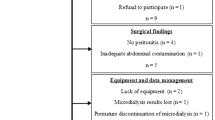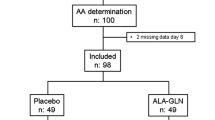Summary
An alanine infusion (90 mg/kg/h) for eight hours was administered to seven patients after cholecystectomy in order to investigate the influence of elevated plasma alanine levels on the postoperative metabolism. The following metabolits and hormone concentrations were analysed in plasma: glucose, urea, free fatty acids, ketone bodies, amino acids, insulin and glucagon. Compared to the pre-infusion values on the 1. postoperative day after an overnight fasting, the following changes were monitored. The plasma glucose concentrations reached a maximum after four hours of infusion (p<0.05). Of the amino acids, significant elevated levels were found for alanine (300%,p<0.001), glutamine (36%,p<0.05), and α-aminobutyrate (61%,p<0.01). The free fatty acids and ketone bodies concentrations decreased immediately after the onset of the infusion of alanine (p<0.05), and increased again during the last four hours of infusion. The secretion of insulin and also the secretion of glucagon were stimulated by the increased alanine levels. The stimulation of insulin reached a maximum after only five minutes, but the glucagon levels increased continously until the end of the infusion.
During the administration of alanine a nitrogen homeostase was achieved, which was a significant improvement (p<0.001) when compared to saline infusions before and after the alanine infusion.
Conclusions: (1) Postoperative increased plasma levels of alanine stimulate gluconeognesis and reduce the plasma levels of lipolytic metabolites. The induced stimulation of insulin and glucagon is dependent on the duration of the alanine infusion for during extended infusion of alanine the insulin stimulation diminishes while the glucagon secretion continously increases. (2) Alanine is a potent anabolic substrate in the immediate postoperative situation.
Zusammenfassung
Bei sieben Patienten wurde am 1. postoperativen Tag nach Cholecystektomie eine achtstündige Alanininfusion (90 mg/kg/h) durchgeführt und der Einfluß des erhöhten Plasmaalaninspiegels auf die postoperative Stoffwechselsituation untersucht. Folgende Metaboliten und Hormone wurden im Plasma bestimmt: Glukose, Harnstoff, freie Fettsäuren, Ketonkörper, Aminosäuren, Insulin und Glukagon. Gegenüber den Basalwerten (1. postoperativer Tag, nach einer 14stündigen Fastenperiode in der Nacht), vor Beginn der Alanininfusion, wurden folgende Veränderungen festgestellt:
Die Plasmaglukosekonzentrationen stiegen bis zur 4. Infusionsstunde an und erreichten hier ein Maximum (p<0.05). Von den Plasmaaminosäuren erhöhten sich die Konzentrationen von Alanin (um 300%,p<0.001), Glutamin (36%,p<0.05) und von α-Aminobutyrat (um 61%,p<0.01). Die freien Fettsäuren und die Ketonkörper sanken unmittelbar nach Beginn der Alanininfusion ab (p<0.05) und stiegen ab der fünften Infusionsstunde wieder an. Sowohl die Sekretion von Insulin, als auch die von Glukagon wurde durch die Alaninzufuhr stimuliert. Die Insulinstimulation erreichte bereits nach 5 min ihren maximalen Wert, während die Plasmaglukagonkonzentrationen bis zum Infusionsende anstiegen.
Eine Berechnung der Stickstoffbilanz ergab nach der Korrektur mit den angestiegenen Plasmaharnstoffwerten eine ausgeglichene Proteinhomöostase unter der Alaninzufuhr. Die Stickstoffbilanz war, verglichen mit Kochsalzinfusionsperioden vor und nach der Alanininfusion, signifikant verbessert (p<0.001).
Aus den Ergebnissen wird geschlossen, (1) daß postoperativ erhöhte Plasmaalaninspiegel zu einer Stimulierung der Glukoneogenese und einem Konzentrationsabfall der lipolytischen Metaboliten im Plasma führen. Die dabei beobachtete Insulin- und Glukagonstimulation ist je nach der Dauer der Alanininfusion unterschiedlich, da nach einer längeren Alaninzufuhr die Insulinstimulation abnimmt, während die Glukagonstimulation andauert, und (2) daß Alanin in der unmittelbaren postoperativen Phase eine eiweißanabole Wirkung hat.
Similar content being viewed by others
Literatur
Adibi SA (1976) Metabolism of branched-chain amino acids in altered nutrition. Metabolism 25:1287–1302
Aulick HL, Willmore DW (1979) Increased peripheral amino acid release following burn injury. Surgery 85:560–565
Allison SP, Hinton P, Chamberlain MJ (1968) Intravenous glucose-tolerance, insulin, and free-fatty-acid levels in burned patients. Lancet 11:1113–1116
Becker DJ, Pimstone BL, Kronheim S, Weinkove E (1975) The effect of alanine infusions on growth hormone, insuline, and glucose in protein-calorie malnutrition. Metabolism 24:953–958
Bergmeyer HU (1974) In: Methoden der enzymatischen Analyse. Verlag Chemie, Weinheim
Bratusch-Marrain P, Björkman O, Wahren J, Waldhäusel W (1978) Der Glucagon/Insulin Quotient: Fehlende Korrelation mit dem hepatischen Glukosemetabolismus. Kongress d.Deutschen Diabetes Gesellschaft, Düsseldorf
Bruckman M, Conway M, Seibel J, Eaton P (1973) Effect of fasting on alanine-stimulated insulin und glucagon secretion. Metabolism 22:1253–1262
Chang TW, Goldberg AL (1978) The origin of alanine produced in skeletal muscle. J Biol Chem 253:3677–3684
Clowes GHA, O'Donnell TF, Blackburn GL, Maki TN (1976) Energy metabolism and proteolysis in traumatized and septic man. Surg Clin North Am 56:1169
Cuthbertson DP (1930) The disturbance of metabolism produced by bony and non bony injury, with notes of certain abnormal conditions of bone. Biochem J 24:1244
Dole VP, Meinertz (1960) Microdetermination of long-chain fatty acids in plasma and tissues. J Biol Chem 235:2595–2599
Dölp R (1975) Free amino acids in plasma in the post-traumatic period. Infusionstherapie 2:231
Felig P (1973) The glucose-alanine cycle. Metabolism 22:179–207
Felig P, Pozefsky T, Marliss E (1969) Alanine: key role in gluconeogenesis. Science 167:1003–1004
Felig E, Wahren J, Hendler R, Brundin T (1974) Splanchnic glucose and amino acid metabolism in obesity. J Clin Invest 53:582–590
Fernandes J, Blom W (1974) The intravenous L-alanine tolerance test as a means for investigating gluconeogenesis. Metabolism 23:1149–1156
Förster H (1976) Carbohydrates in parenteral nutrition. Nutr Metabol 20:57–75
Giddings A, Mangnall D, Rowland B, Clark R (1977) Plasma insulin and surgery I (early changes due to operation in the insulin response to glucose). Ann Surg 186:681–693
Kerr D, Stevens M, Picow D (1978) Fasting metabolism in infant II. The effect of severe undernutrition and infusion of alanine on glucose production estimated with U13-C-glucose. Metabolism 27:831–848
Jeevanandam M, Long CL, Kinney MD (1979) Kinetics of intravenously administered15N-L-alanine in the evaluation of protein turnover. Am J Clin Nutr 32:975–980
Kinney J, Felig P (1979) The metabolic response to injury and infection. Endocrinology, Vol III, De Groot LJ (ed). Grune & Stratton, New York
London DR, Foley TH, Webb CG (1965) Evidence for the release of individual amino acids from the resting human forearm. Nature 208:588
Long C, Kinney J, Geiger J (1976) Nonsuppressability of gluconeogenesis by glucose in septic patients. Metabolism 25:193–201
Long J, Wilmore D, Mason A, Pruitt B (1977) Effect of carbohydrate and fat intake on nitrogen excretion during total intravenous feeding. Ann Surg 185:417–422
Meguid MM, Brennan MF, Aoki TT et al. (1974) Hormone-substrate interrelationships following trauma. Arch Surg 109:776–783
Ozand PT, Tildon JT, Stevenson JH (1976) Ability of exogenous alanine to lower blood β-hydroxybutyrate during development of rats. Am J Physiol 230:1385–1388
Parnas J, Wagner R (1921) Über die Ausführung von Bestimmungen kleiner Stickstoffmengen nach Kjehldahl. Biochem Z 125:253
Rubenfeld S, Garber A (1978) Abnormal carbohydrate metabolism in chronic renal failure. J Clin Invest 62:20–28
Schultis K (1970) Veränderungen im Kohlenhydrat und Fettstoffwechsel nach Operationen und Traumata. Habilitationsschrift, Gießen 1970
Snedecor GW, Cochran WG (1967) Statistical methods, 6th edn. Iowa State University Press, Ames Iowa
Unger RH (1971) Glucagon and the insulin: glucagon ratio in diabetes and other catabolic states. Diabetes 20:834
Vinnars E, Bergström J, Fürst P (1975) Influence of the post-operative state on the intracellular free amino acids in human muscle tissue. Ann Surg 182:665–671
Waterhouse Ch, Keilson J (1978) The contribution of glucose to alanine metabolism in man. J Lab Clin Med 92:803–812
Wolfe B, Culebras J, Sim A, Ball M, Moore F (1977) Substrate interaction in intravenous feeding, comparative effects of carbohydrate and fat on amino acid utilization in fasting man. Ann Surg 186:518–540
Woolfson A, Heartly R, Allison S (1979) Insulin to inhibit protein catabolism after injury. N Engl J Med 300:14–17
Zierler KL, Rabinwitz D (1964) Effect of very small concentrations of insulin on forearm metabolism. Persistance of its action of potassium and free fatty acids without its effect on glucose. J Clin Invest 43:950
Author information
Authors and Affiliations
Rights and permissions
About this article
Cite this article
Funovics, J., Roth, E., Mühlbacher, F. et al. Alanin als stickstoffsparendes und glukoneogenetisches Substrat im postoperativen Zustand. Klin Wochenschr 59, 797–802 (1981). https://doi.org/10.1007/BF01724686
Received:
Accepted:
Issue Date:
DOI: https://doi.org/10.1007/BF01724686




